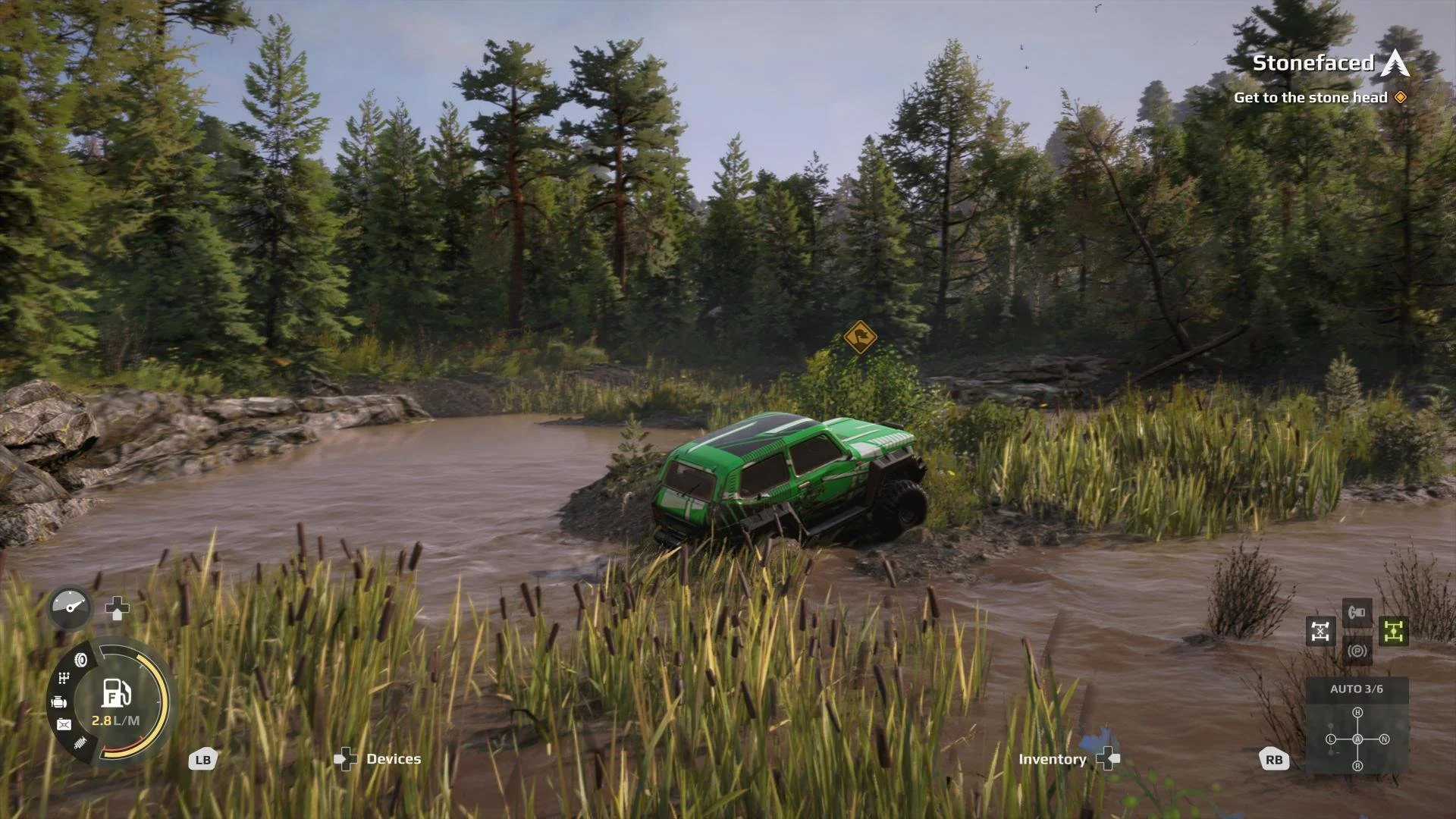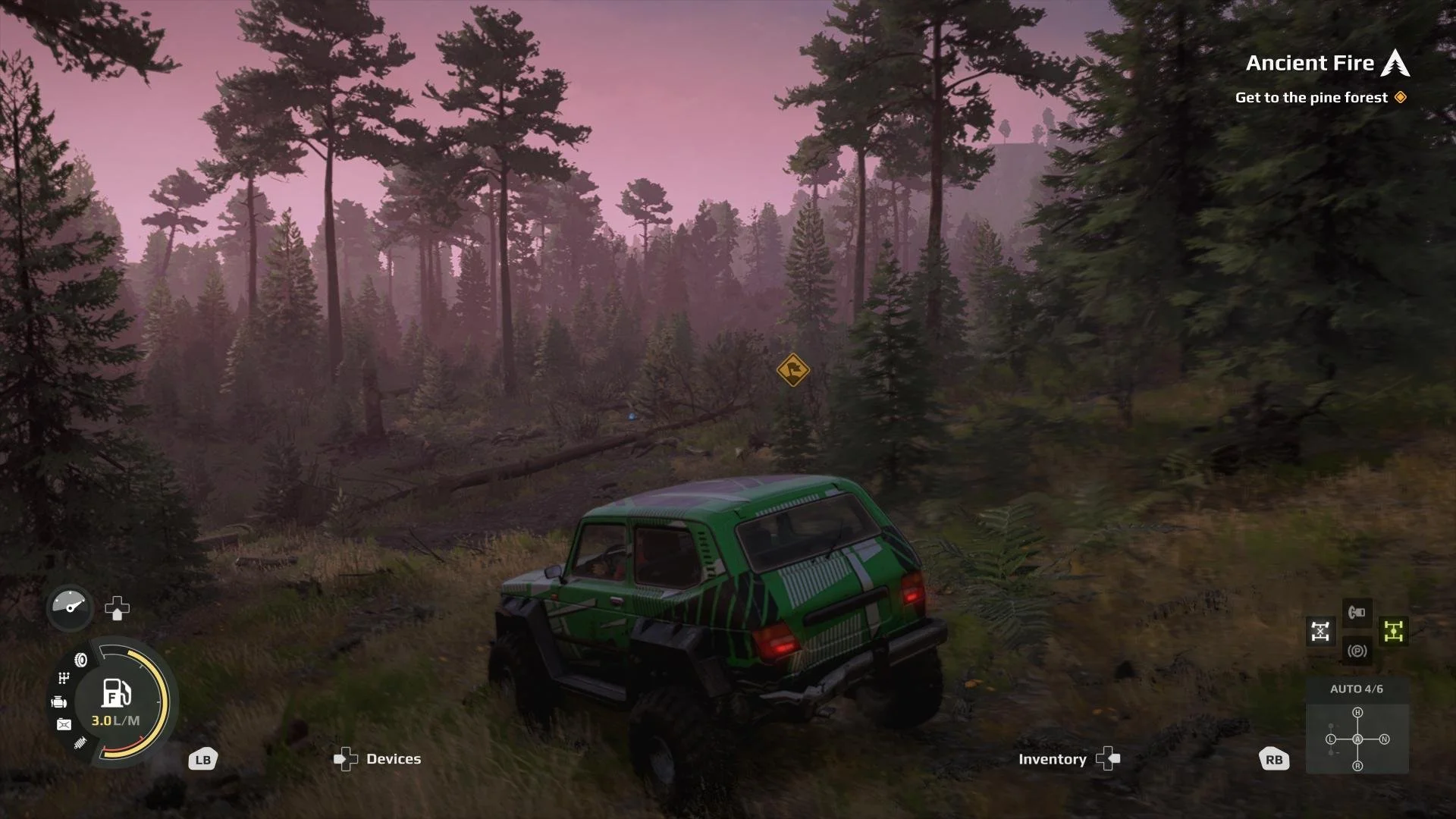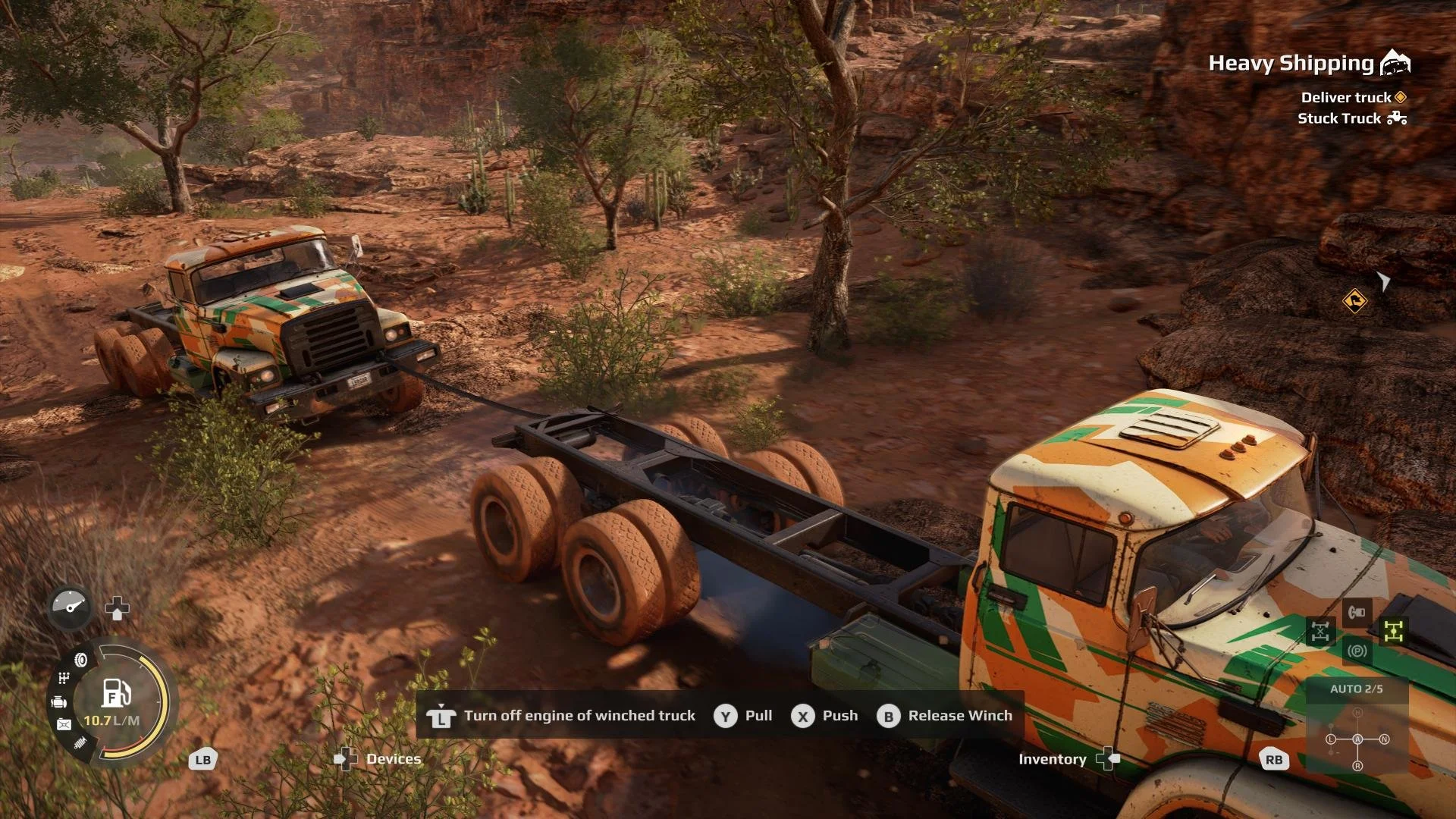Stuck in the mud.
If there was ever a game I wish I simply had more time to play, it would likely be SnowRunner, the follow-up to 2017’s MudRunner. The satisfaction of pulling off a mission, no matter how trivial, granted that game a lot of its enjoyment. Finding a rig stuck somewhere across its open world and then hauling it back to your client was constantly satisfying, especially undertaking the whole game in co-op. So when Expeditions: A MudRunner Game was announced I set aside the time to play it, even if I was thinking about SnowRunner the entire time.
Expeditions: A MudRunner Game, much like its predecessors, is technically a puzzle game built around traversing difficult terrain as you find the right truck for the right job. However, the expedition side of this latest release holds back on the best ideas that came before it, often having you simply drive around and map out the area. Sure, sometimes you’ll toss out scanners or other scientific equipment, but most missions just end with you simply driving around as the percentage meter increases. Now, that said, some of the best qualities of the previous games are here. There are countless vehicles to haul out of various mud pits and swamps, but the bulk of the missions leading up to those moments really drag out the worst qualities of this release. Is Expeditions: A MudRunner Game fun? Yes, but like the vehicles you’ll be hauling out and back to your base camp, they are buried deep in and require a lot of effort to even get there.
Where a great deal of my frustration lands with this title is that you can often undo an entire mission with one single minor mistake. There are no save states to set you back on the path, it is either spending the money and inventory space to ensure you have the tools needed to get out of numerous predicaments or using the funds you have to teleport back to your basecamp and try again, with the first few towings free of charge. That said, you then sometimes will need to spend 20-30 minutes expending the fuel to get back to even where you were, sometimes running out of fuel or the tools needed to complete the job, forcing you to just start the whole mission over. Now granted, that is part of the appeal here, but it often becomes a double-edged sword as it can also be the downfall of a good time.
One such moment happened when I was 98% done exploring a location, only to accidentally get stuck with nothing around me to tow myself to freedom. I had already spent my anchors, and the game doesn’t let you retrieve them after they have been used. Instead, I had to teleport to my base camp and spend nearly 20 minutes getting back there for the remaining 2%. Was I to travel to haul something back to my encampment then I’d be more willing to do so, but these scans just were never compelling and felt like filler in the worst possible way.
On the other end of the coin is that trudging through swamps and various rocky terrain can be incredibly enjoyable, especially when you have upgraded your truck with the appropriate tires or engine, beefing up the power under the hood, even if you never really feel any sort of speed from your truck. The driving itself is still rather fun despite you never really moving too fast. While the first-person cab viewpoint is borderline unplayable, there are numerous FOV settings to make both styles far more enjoyable.
While you’ll start to collect more vehicles, or purchase the DLC pass to shortcut some of that, earning new vehicles takes time, so you’ll get to know the ones you have rather well, decking them out in numerous colors, roof racks, rims, and various trim around their design. It’s not a wildly inventive or in-depth system, but it does just enough to convert a truck you’ve driven for 10-15 hours into something entirely new, especially as you’ll easily get well over 80-100 hours here should you invest the time to complete each map, mission, and side activity that comes your way.
This is why I revert back to this game being more puzzler than a driving game simply due to all the moving parts needing to be understood and followed. SnowRunner had elements of this to its core, but its world and structure simply felt better as it often hid its puzzle-like nature from me due how great I found the driving and traversing its world to be. I also found the missions to be more worthwhile, and the tasks in front of me to be more compelling. While I adore the driving aspects here, the more puzzle-like elements start to show up prominently due to the bland mission design and reliance on its expedition-centric science narrative. Knowing it’s a puzzle game is one thing, but having it feel like one is where Expeditions often lost me.
For those wanting the driving elements to be front and center, those aspects are still there. You have to watch your fuel, carry reserves, as well as repair parts should your vehicle take damage as you slam into rocks and various formations of its terrain. You have to switch from your two-wheel drive to four-wheel drive often to attempt steep climbs or push through boggy swamps or one of a thousand mud pits, using more fuel as you also tend to your tire pressure. All the meters are here, the aspects that make this a driving game, but again, you are using those elements as parts in a puzzle, ensuring you have a winch to pull you free, equipment that can realign a tipped truck, ground anchors to attach a winch to when a tree is simply a bit too far, to an echo sounder to determine the depths of any body of water. There is a lot to take in here and thankfully, all of it works well and much of it returns from SnowRunner. From that angle, Expeditions succeeds in not only having those elements return but can feel a bit more straightforward and make it a bit more approachable. It doesn’t always land the mark, but it shows that Saber Interactive is fine-tuning the driving aspects to new heights.
Expeditions: A MudRunner Game has you working across three biomes; Little Colorado, Arizona, and the Carpathians. Each location has additional maps of their own such as Arizona taking you to the Grand Canyon, and Carpathians setting course for Mountain Labyrinths and SlipRock Swamps, among several others. The biggest issue is that while there are three locations, Little Colorado is not only a very tiny map, but it shares the exact aesthetic of Arizona, making there really only feel like two locations here. In fact, Little Colorado only has a half dozen missions where you’ll find nearly 40 out of the other two locales.
Each location has you hauling monitoring stations or surveying the landscape for a quick photograph or taking your drone for a quick flight. You’ll find yourself pinging a beacon here and there as you scan the water for numerous metals or find the remnants of an old plane. Many of your missions have you recruiting an expert, with the more thorough ones being unlocked as you complete certain missions. These experts do come with various perks like increased repair parts or making note of shortcuts, but apart from some basic dialogue, they don’t feel like real characters. Missions are unlocked as you complete more, with many tied to one mission from the next. This means you can often be stuck for a while on a bad mission when you have little options in what is available to you next.
Environments have various camps to spawn from with small supply stations you can purchase to top you up when your resources are low. Some locations are found on the map that transfer you to a new environment, often providing additional camps to use as fast travel locations, provided you have the cash to afford the tow. And as you explore more of the maps, you’ll track down those new areas, especially as some missions early on may not have an objective marker leading the way. And, since you don’t know where they are, most of the time you’ll have to ensure you have the fuel reserves to go on a drive to then find them.
From a visual standpoint, there are times when this game is flat-out gorgeous, with vistas and details that are begging to be viewed. However, for as good as this game can look, the version of the game I played on Series X would not have ground textures fully load in nearly 90% of time, only popping in when I would adjust the camera just right. This was constant throughout my nearly 50 hours with the title. While I didn’t have significant framerate issues or black flickering as I have seen in other reviews and coverage of the game, this was one issue that plagued my entire playthrough.
While Expeditions: A MudRunner Game will eventually have co-op, currently, there is no release date planned on when this feature will arrive, and while SnowRunner was a game I adored even on my own, co-op made that game truly sing. Right now, Expeditions is a technical mess on Xbox Series X due to its texture issue and some other oddities that show up from time to time. So with that and the lack of co-op at launch, this is a game I can only recommend once those issues have been addressed and co-op eventually added. I think Expeditions is a solid experience when it brings with it the best qualities of its past, but there are times when the title doesn’t do a good enough job at hiding the puzzle-like nature of what these titles are at their core. While Expeditions does a great deal to be more streamlined and accessible, all it did was make me wish I was playing SnowRunner instead.
Developer - Saber Interactive. Publisher - Focus Home Entertainment. Released - February 29th, 2024. Available On - Xbox One/Series X/S, PS4/PS5, Nintendo Switch, Windows. Rated - (E) No descriptors. Platform Reviewed - Xbox Series X. Review Access - Review code was provided by the publisher for the purpose of this review.















Jeff is the original founder of Analog Stick Gaming. His favorite games include The Witcher III, the Mass Effect Trilogy, Hi-Fi Rush, Hellbade: Senua’s Sacrifice, and the Legend of Heroes series, especially Trails of Cold Steel III & IV.